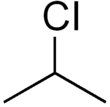Chemistry:Isopropyl chloride
|
| |||
| Names | |||
|---|---|---|---|
| Preferred IUPAC name
2-Chloropropane | |||
| Other names
Chlorodimethylmethane, isopropyl chloride, 2-propyl chloride, sec-propyl chloride, 2-chloropropane
| |||
| Identifiers | |||
3D model (JSmol)
|
|||
| ChemSpider | |||
| EC Number |
| ||
PubChem CID
|
|||
| RTECS number |
| ||
| UNII | |||
| UN number | 2356 | ||
| |||
| |||
| Properties | |||
| C3H7Cl | |||
| Molar mass | 78.5413 | ||
| Appearance | Colorless liquid | ||
| Odor | sweet, ether-like | ||
| Density | 0.862 | ||
| Melting point | −117.18 °C (−178.92 °F; 155.97 K) | ||
| Boiling point | 35.74 °C (96.33 °F; 308.89 K) | ||
| 0.334 g/100 ml at 12.5 °C | |||
| Solubility in ethanol | miscible | ||
| Solubility in diethyl ether | miscible | ||
Refractive index (nD)
|
1.3811 | ||
| Viscosity | 4.05 cP at 0 °C 3.589 cP at 20 °C | ||
| Hazards | |||
| Main hazards | Highly flammable, possible mutagen. May be harmful by ingestion, inhalation or through skin contact. | ||
| Safety data sheet | External MSDS | ||
| GHS pictograms |  
| ||
| GHS Signal word | Danger | ||
| H225, H302, H312, H332 | |||
| P210, P233, P240, P241, P242, P243, P261, P264, P270, P271, P280, P301+312, P302+352, P303+361+353, P304+312, P304+340, P312, P322, P330, P363, P370+378, P403+235, P501 | |||
| NFPA 704 (fire diamond) | |||
| Flash point | −32 °C (−26 °F; 241 K) | ||
| Related compounds | |||
Related alkyl halides
|
Ethyl chloride n-propyl chloride Isopropyl bromide Isopropyl iodide | ||
Except where otherwise noted, data are given for materials in their standard state (at 25 °C [77 °F], 100 kPa). | |||
| Infobox references | |||
Isopropyl chloride is an organic compound with the chemical formula (CH3)2CHCl. It is a colourless to slightly yellow, volatile, flammable liquid with a sweet, ether-like (almost like petroleum) odour. It is used as an industrial solvent.
It is produced industrially by the addition of HCl to propylene:[1]
- CH3CH=CH2 + HCl → (CH3)2CHCl
Isopropyl chloride can be easily produced in the lab by reacting concentrated hydrochloric acid with isopropyl alcohol in the presence of a calcium chloride or zinc chloride catalyst. The common ratio of alcohol to acid to catalyst is 1:2:1 using 30% HCl and near pure isopropyl alcohol. The reaction mixture is refluxed for several hours, or distilled over several hours. The isopropyl chloride is then separated from the remaining isopropyl alcohol by washing with water (the isopropyl chloride will form in insoluble layer above the water, while the alcohol will dissolve into solution along with any HCl present).
In the presence of a catalyst, dry isopropyl chloride reacts with magnesium to give isopropylmagnesium chloride.[2]
When burned, isopropyl chloride releases copious amounts of hydrogen chloride gas, water vapor, carbon oxides, and some soot. It burns inefficiently with a smoky, yellowish flame.
Further reading
- Ann Smith, Patricia E. Heckelman (2001). "The Merck Index". in Maryadele J. O'Nei. An Encyclopedia of Chemicals, Drugs, and Biologicals (Thirteenth ed.). Whitehouse Station, NJ: Merck & Co., Inc.. pp. 932.
References
- ↑ M. Rossberg (2006). "Ullmann's Encyclopedia of Industrial Chemistry". Ullmann's Encyclopedia of Industrial Chemistry. Weinheim: Wiley-VCH. doi:10.1002/14356007.a06_233.pub2.
- ↑ Johnnie L. Leazer, Jr; Raymond Cvetovich (2005). "A Practical and Safe Preparation of 3,5-Bis(trifluoromethyl)acetophenone". Org. Synth. 82: 115. doi:10.15227/orgsyn.082.0115.
 |




